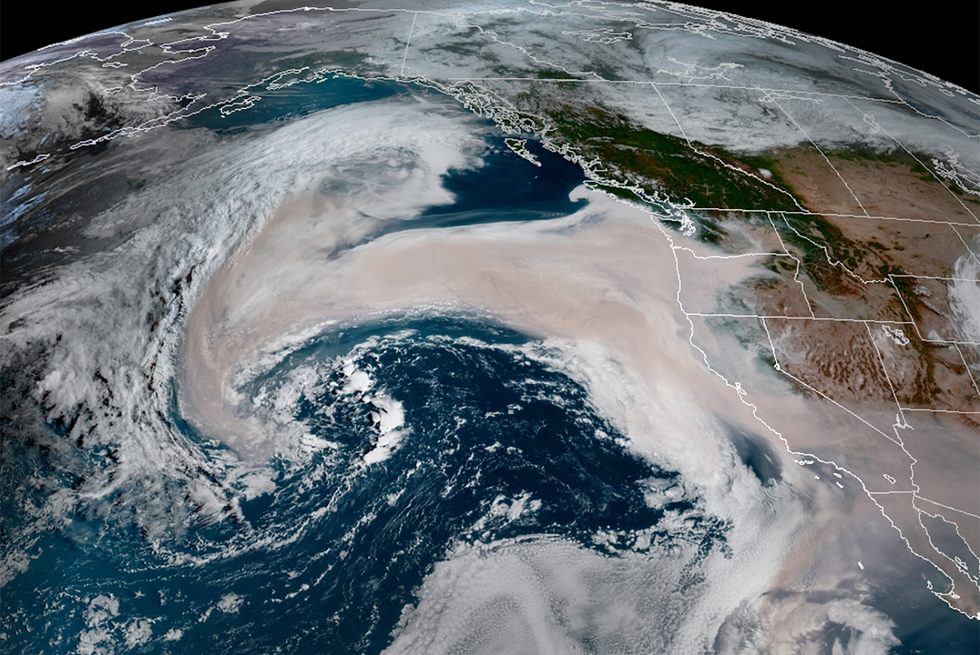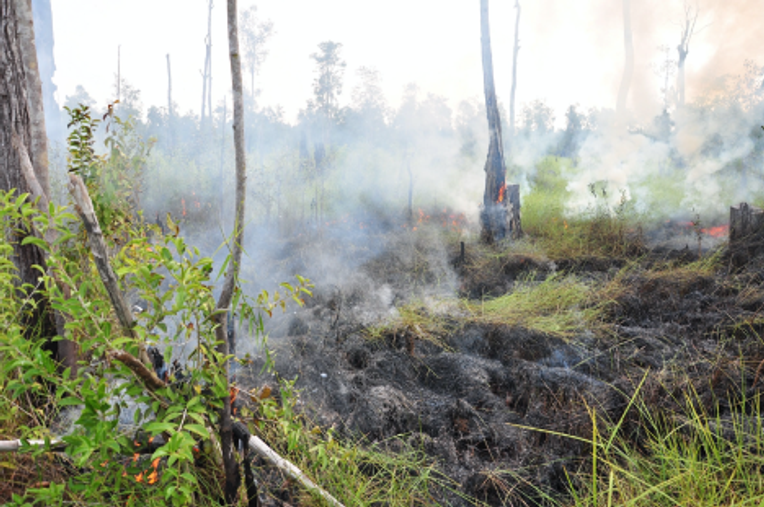Southeast Asia’s Smoldering Peat Fires amid Viral Pandemic
From the Series: Firestorm: Critical Approaches to Forest Death and Life
From the Series: Firestorm: Critical Approaches to Forest Death and Life

Forget carbon, forests’ new environmentalism is all about aerosols.
Forests detoxify our air. At least, that’s the story those of us who grew up in the 1970s and 80s were told, celebrating the early Earth Days with “Think global, act local” slogans, often with an icon of the Amazon behind it. The lungs of the earth, generating oxygen so us humans and other breathing bodies can live without thinking much about where or how we breathe.
Yet we can no longer take forests for granted as Earth’s purifiers. Deforestation, decades of forest fire mismanagement, and weather that deviates dramatically from seasonal climatic norms have converged in maelstroms: across California, Australia, Brazil, and Indonesia forests now burn ferociously in ways that have little historical analogy. In Indonesia, the country’s vast tropical peatlands have become a fire epicenter. Tropical peat should be underwater most of the year; water prevents the carbon-dense layer full of decaying vegetation from burning and also oxidizing, both processes that emit carbon dioxide. But following extensive peat swamp drainage over the past few decades (largely for plantation agriculture, but that’s another story), peatlands in Sumatra and Kalimantan (Indonesian Borneo) have turned into smoke fields.

The fires’ carbon dioxide emissions have gotten broad attention (globally, if not locally), turning peat fire prevention into a bulwark against climate change. But for residents ranging from village inhabitants living outdoors in the peatlands to urban dwellers in Singapore and many cities across Indonesia, carbon dioxide is the least of their worries. Peat fires discharge toxic gases and particulate matter—innocuously known as “haze” across Southeast Asia—into the breathing space of hundreds of millions of people. Fires in 2015, the worst in the past two decades, smoldered in Indonesia from August through November as images of the other-worldly air quality and daily Air Quality Index (AQI) stats reverberated across social media. Singapore attracted much international dismay during the 2015 fire episode for crisis-level air pollution that lingered over the urban city-state for months. But as bad as the air quality was in Singapore, it was five to ten times worse in the parts of Indonesia closer to the fires.
Scientists have been studying the composition of smoke chemistry that occurs when peat combusts. During the 2015 fires, a NASA-funded team deployed a robot, a remote controlled, rugged rolling cart protected from smoke and dust with tarps able to maneuver over crumbling, smoldering, and soggy peat soil, to capture smoke samples directly from the soil. Using a spectrometer attached to the robot, Chelsea E. Stockwell et al. (2016) found that of the dozens of gases and particulates released from the 2015 fires, formaldehyde may be the most dangerous. But most of the trace gases and particulates—aerosols—emitted are a hazardous threat to human lungs, entering the same airways that the coronavirus invades and causing damage that starts in the lungs but can radiate to the cardiovascular system.
Aerosols are everywhere a threat these days. Aerosols have entered our lexicon as the wave on which the coronavirus tumbles through the air with a chance at entering our breathing passages. Droplets, particles, spittle: bodily waste that few would have spoken of outside the context of perhaps a doctor’s office. By summer of 2020, aerosols were all over the media, in rendered diagrams illustrating the radius of a sneeze and mentioned in relation to “toilet plumes.” Like the miasma that was thought to cause pandemics of the past, or even malaria (“bad air” in Italian, previously called—not coincidentally—marsh fever for its association with swamps) aerosols have become an abstract, oppressive death threat during the pandemic. Images of other bodies hooked up to ventilators, their faces obscured (or sometimes, not) by plastic parts and white sheets have infiltrated our collective pandemic memory. Many of them haven’t, or won’t, rejoin the lives of the breathing anytime soon. Others will, but with difficulty over the coming months and years, as “otherwise healthy” people cursed with long COVID will gasp as they walk upstairs, pause to catch their breath, take out an inhaler.
Aerosols are tiny solids or liquids suspended, hovering, in air. They are sometimes beautiful, like the mist of a waterfall, fog rolling in from the ocean, earthy incense smoke. Sometimes they are deadly. Aerosols can contain viruses riding in liquids and they can be solid pollutants from fossil fuel burning. From any combustion, including peat fire, emanates fine solid particulates, often called PM2.5 in reference to their microscopic diameter. As we inhale, aerosols penetrate the deepest nodules of our lungs.
The last time I saw a young friend of mine in Kalimantan, in a provincial capital city close to some of the most severe 2015 peat fires, was at a donut shop in early 2017. She was in college now; she showed me the Instagram account she was using to make extra cash buying makeup from Jakarta and reselling it to local friends. What was it like here, at this donut shop and nearby, during the 2015 fires that turned the sky a putrid orange for weeks, I asked her. She got quiet. I had to stay in the hospital, she put a hand on her chest, because of . . . she struggled to find the word. Pneumonia? I asked. Yes, she nodded vigorously, and I had to use an inhaler for months. She made the pumping motion with her hand. I thought I was going to die, she said. Otherwise healthy, age twenty-one.
The air we breathe should be a great equalizer: all humans and many nonhumans breathe, need, air. But it’s far from true that everyone has access to the same air, or to air that sustains life well. Both the pandemic and peatlands’ fires make that clear. The air we breathe varies in quality not just across large scales—imagine taking a deep breath in Beijing versus in the Nordic countryside—but across microscales. The unmasked delivery man driving a motorbike through Jakarta’s eight-lane highways at rush hour is not breathing the same air as the businesswoman in the back of a taxi with the windows rolled up in the next lane over, her breathing space filtered by air conditioning.
The predominant metric deployed to curb tropical deforestation—and for preventing fires in Indonesia’s peatlands—has been carbon. Programs such as the United Nations’ REDD+ (Reduced Emissions from Deforestation and Forest Degradation) have tried to slow deforestation by making the carbon stored within trees valuable to investors through carbon offset regimes. But by and large, caring for and about carbon has not succeeded at turning the tide on global tropical deforestation. Could the compounding health threat of toxic air amid viral pandemic galvanize action on climate change where carbon metrics and emphasis on the atmosphere rather than our intimate breathing space have failed?
Stockwell, Chelsea E., Thilina Jayarathne, Mark A. Cochrane, Kevin C. Ryan, Erlanto I. Putra, Bambang H. Saharjo, Ati D. Nurhayati, et al. 2016. “Field Measurements of Trace Gases and Aerosols Emitted by Peat Fires in Central Kalimantan, Indonesia, during the 2015 El Niño.” Atmospheric Chemistry and Physics 16: 11711–32.